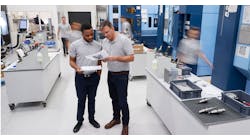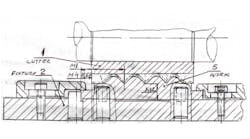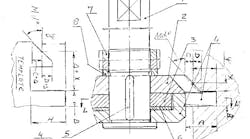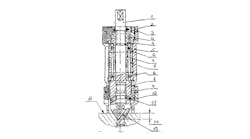Following an earlier proposal for transcribing the angle of hob profile teeth measured in inches, our correspondent now describes how to execute a similar task with metric measurements:
“The U.S. produces a huge quantity of good quality metric module involute hobs for Europe, Japan and other countries that use the metric system. My idea is a technique for converting any module metric involute hob to another hob, and vice versa, if these hobs have the same pitch (distance between teeth.)
“First, we have a group of module gear hobs with 14.5 and 20 degree pressure angles and a second group module spline shaft hobs with 30, 37.5, and 45 degree pressure angles. These two groups have teeth with trapezoidal profiles.
“Converting is done between hobs in the first group, between hobs in the second group, and between hobs of the first and second groups in any two hobs and vice versa. We have many combinations and possibilities that can help us in any emergency situation, and to start by simply grinding and relieving one profile tooth to another. We can grind any large angle profile tooth to a small one, and the process can be done in reverse, too.
“Computer programs and tables show that in the first group (for gear hobs) converting starts from module = 0.5 to module = 6 mm for any angle of profile.
“Converting for the second group starts for the 30 degree grinding to 37.5 degrees, and vice versa, from module -0.25 mm to module = 6 mm, for other angles from module = 0.25 mm to module = 2.5 mm.
“Converting between any angles of the first and second group starts from module = 0.5 mm to module = 2.5 mm. Very effective conversion can be done for smaller modules, too.
“Computer programs and algorithms can be checked by graphically by inscribing one tooth into another, and vice versa. What I am doing is drawing, in 20:1 scale or more, two or three teeth of hobs with one profile angle on tracing paper, or using CAD and zoom function, and inscribing this drawing into another drawing of 2-3 teeth hob with another profile.
“Drawing can be done by measuring on an optical comparator or calculating using standard formulas. I also use a computer (CAD, Zoom) to draw conversions.
“In any event, the two compiled and inscribing drawings show how much material can be removed from the source teeth to create the size of the new hob. As a precaution though, I make a test cut before actually producing gears and spline shafts. This method is called MLG.



